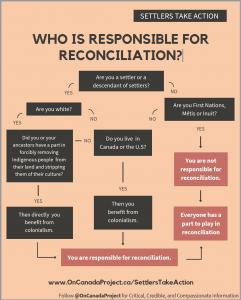St. Denis, V. (2011). Silencing Aboriginal curricular content and perspectives through multiculturalism: “There are other children here”. Review of education, pedagogy, and cultural studies, 33(4), 306-317.
Just like my last post about multiculturalism, Denis (2011) makes another point against it as a national policy. The argument is that multiculturalism reduces Indigenous cultures into one of many other “ethnic” groups, which downplays Canada’s colonial history and direct genocidal practices that have targeted Indigenous Peoples throughout its history. This point adds to my growing list of evidence that both intercultural studies and complete decolonization are the most important elements to consider in the rethinking of how to best “indigenize” the curriculum. There needs to be a shift in education from “learning about them” to “learning about each other,” and until the framework under which we operate is able to be completely decolonized, superiority complexes will remain. Denis also argues that this new framework of equality needs to include the removal of thinking of “racial minorities,’ are these are socially constructed terms that imply inferiority and enforce the “majority’s” position of privilege in the discussion. This was a great last article to read as a part of my entries because I feel as though it has enforced my new perspectives on the issue. I began my research with a bit of an expectation as to what the answer may be, but this may have come from my own position within our current education frameworks. The promotion of intercultural education, along with direct initiatives to educate new immigrants, in tandem appear to be the best course of action to bridge the apparent gap between the two major population groups in Canada.
